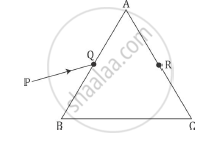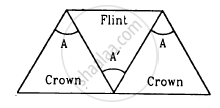Advertisements
Advertisements
Question
An equilateral glass prism has a refractive index 1.6 in the air. Calculate the angle of minimum deviation of the prism, when kept in a medium of refractive index `4sqrt(2)"/"5.`
Solution
When the prism is kept in another medium we have to take the refractive index of the prism with respect to the provided medium.
`"medium"^μ = ("μ"_"prism")/("μ"_"medium") = sin[((A + D_m)/2)]/sin(A/2)`
`1.6/((4sqrt(2))/5) = sin[((60^circ + D_m)/2)]/sin(60^circ/2)`
`sqrt(2) = sin[((60^circ + D_m)/2)]/(1/2)`
`sin^-1(1/sqrt(2)) = ((60^circ + D_m)/2)`
`90^circ = 60^circ + D_m`
`D_m = 30^circ`
APPEARS IN
RELATED QUESTIONS
A ray PQ incident on the face AB of a prism ABC, as shown in the figure, emerges from the face AC such that AQ = AR.

Draw the ray diagram showing the passage of the ray through the prism. If the angle of the prism is 60° and refractive index of the material of prism is `sqrt3` , determine the values of angle of incidence and angle of deviation
Out of blue and red light which is deviated more by a prism? Give reason.
Can the dispersive power \[\omega = \frac{\mu_u - \mu_r}{\mu - 1}\] be negative? What is the sign of ω if a hollow prism is immersed into water?
The angular dispersion produced by a prism ___________ .
A thin prism is made of a material having refractive indices 1.61 and 1.65 for red and violet light. The dispersive power of the material is 0.07. It is found that a beam of yellow light passing through the prism suffers a minimum deviation of 4.0° in favourable conditions. Calculate the angle of the prism.
Three thin prisms are combined as shown in figure. The refractive indices of the crown glass for red, yellow and violet rays are μr, μy and μv respectively and those for the flint glass are μ'r, μ'y and μ'v respectively. Find the ratio A'/A for which (a) there is no net angular dispersion, and (b) there is no net deviation in the yellow ray.

The refractive index of a material M1 changes by 0.014 and that of another material M2 changes by 0.024 as the colour of the light is changed from red to violet. Two thin prisms, one made of M1(A = 5.3°) and the other made of M2(A = 3.7°) are combined with their refracting angles oppositely directed. (a) Find the angular dispersion produced by the combination. (b) The prisms are now combined with their refracting angles similarly directed. Find the angular dispersion produced by the combination.
The deviation produced for violet, yellow and red lights for crown glass are 3.75°, 3.25° and 2.86° respectively. Calculate the dispersive power of the crown glass.
Calculate dispersive power of a transparent material given : nv = 1.56, nr = 1.54, ny = 1.55.
How does the angle of minimum deviation of a glass prism vary if the incident violet light is replaced by red light?
